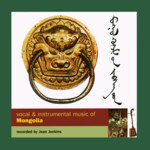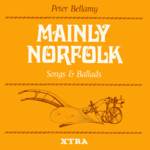> Folk Music > Records > Vocal and Instrumental Music of Mongolia
Vocal and Instrumental Music of Mongolia
 |
Vocal and Instrumental Music of Mongolia Topic Records TSCD909 (LP, UK, 1994) |
Released under licence from Tangent Records. In 1977 Tangent Records released Vocal Music of Mongolia and Instrumental Music of Mongolia as two separate long playing analogue records that are here presented on one CD.
All Mongolians are expected to sing and play the morinxuur or horse head fiddle. Indeed, all the steppeland people—Kazakhs, Kirghiz, many Siberian peoples as well as Mongolians—prize singing and sung poetry. Songs are basically of two types:
- lyrical songs, with drawn out syllables, rich vocal ornamentation, an astonishing wide range,
- short songs, are quicker, more direct and less free than the long songs.
Both type are predominantly pentatonic. A third type of music, work song, is used particularly while milking, but also to accompany games and sports.
Mongolian instrumental music hardly exists in itself; the main function of instruments is to follow and further embellish the human voice. It is the song, poetry and melody, which is supreme. Among the instruments, however, the morinxuur, a two-stringed fiddle with horse-head scroll and deep tone, is outstanding. The transverse flute, limbe, is the other instrument which most men can play; a flute helps pass the time for boys or men watching their animals. The limbe, together with the morinxuur, often accompanies long songs. The other instruments—the long lute, shanz, usually played by women; the long zither, yatga, formerly part of the Mongolian court orchestras and today used only in ensembles; the yenchin, or dulcimer; the hoxuur; and today even the jew’s harp—these are played by few people, usually professional musicians, in contrast to the morinxuur and limbe which are part of the traditional life of all Mongolian men.
Field recordings from April-May 1974 and notes by Jean Jenkins.
Tracks
Vocal Music
- Sumya & Orchibat: The Sun That Shines Above the Earth long song (3.53)
- Monyi: The Ten Fingers on the Hand / The Fifteen Day Moon short songs (3.56)
- Dorj Dawa: My Beautiful Brown Horse long song (4.31)
- Jambal: In Praise of Horses praise song (1.21)
- Tserendulam: In Praise of Life in a Ger praise song (1.05)
- Lamja: My Little Bay Horse long song (5.12)
- Sundui: Mouth music (2.33)
- Milking songs (3.44)
- Dolamjov: Wrestler’s song (2.07)
- Finger Games (Dembee and Khualakh (6.06)
- Shagai-harvah (6.06)
- Sumja: My Beautiful Hangai Land long song (2.45)
Instrumental Music
- Demdinsun, Gemain Gombodrij: Morinxuur solos (3.17)
- Dorj Maldar, Cholumbat: Limbe solos (4.04)
- Dambijantson Gogoy: Hoxuur solo (2.18)
- Khatar: Shanz solo (1.20)
- Monghur: Yatga solo (3.09)
- Aiyush: Morinxuur solo (2.15)
- Sumya & Orchibat: Long song accompanied by morinxuur (3.04)
- Dorj Dawa: Domun long song (5.26)
- Chimiddorj: Jew’s harp solos (3.16)
- Sundai: Mouth music (1.33)
- Endenchimig: Yenchin solo (2.35)
- Nonar: Morinxuur solo (1.11)
- Gemain Gombodrij: Morinxuur solo: The Boundless Space (2.09)
Tracks 1, 5, 9, 10a, 11a, 12, 19 recorded in Arvay Heere, Överhangai Aimak, Central Mongolia;
Tracks 2, 8a, 23ab recorded in Khalium, Gobi Altai district, South West Mongolia;
Tracks 3, 6-7, 10b-e, 13b, 21ab, 22, 25 recorded in Ulan Bator, Mongolia;
Tracks 4, 8b, 13a, 14b recorded in Biger, Gobi Altai district, South West Mongolia;
Tracks 11b, 16, 17ab, 18, 24 recorded in Gobi Altai, South West Mongolia

